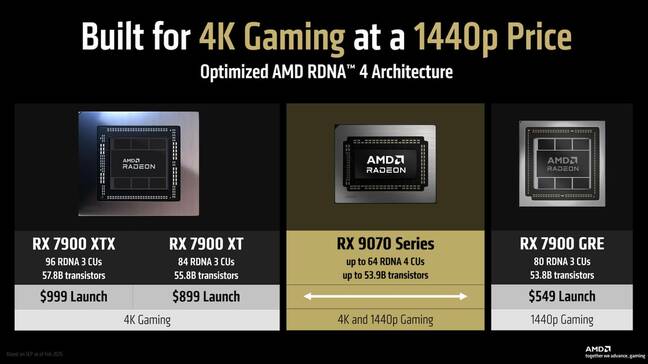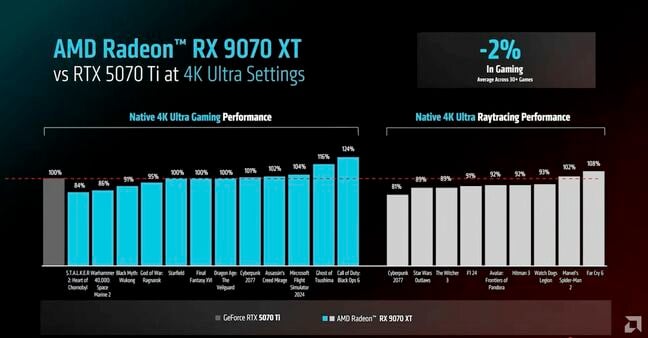AMD Looks To Undercut Nvidia, Win Gamers' Hearts With RX 9070 Series
With the launch of AMD's RX 9070-series graphics cards, AMD is going back to its roots. Rather than trying to compete with Nvidia on raw performance with another flagship GPU beyond the means of most gamers, the House of Zen aims to undercut its competitor by delivering more frames per dollar.
AMD has employed various versions of this strategy over the years – its core-packed Ryzen processors come to mind – and by focusing on the mid-tier segment, AMD clearly aims to capitalize on growing discontent with Nvidia's sky-high prices this generation.
The House of Zen is billing its $549 RX 9070 and $599 9070 XT graphics cards as delivering 4K performance at 1440P pricing. But, while the cards are certainly capable of 4K gaming, especially with AMD's AI upscaling and frame gen tech enabled – more on those in a bit – it's clear these cards are designed primarily with high-refresh rate 1440p gaming in mind.
This is reflected in AMD's positioning of the cards, which slot in behind its now two-year-old RX 7900 XT and XTX graphics cards designed for 4K gaming, and ahead of its previous 1440p power house the 7900 GRE.

As you can see the new chips slot in somewhere between its last-gen flagships and its previous 1440p champion the RX 7900 GRE - click to enlarge
It also makes sense when you consider just how few folks are actually gaming at 4K. According to Steam's latest hardware survey, more than three-quarters of PC gamers are running monitors at 1440p or lower, and just 4 percent are running at 4k or higher.
In terms of performance, AMD says the RX 9070 will deliver between 20 and 21 percent higher frame rates on average compared to its prior-gen RX 7900 GRE at 1440p and 4K respectively. The XT variant, meanwhile, promises an average uplift of 38 to 42 percent at those same resolutions.
As for how they compare to Nvidia's chips, AMD is going after Nvidia's RTX 5070 and 5070 TI graphics cards. During AMD's launch event, David McAfee, VP and GM of AMD's client business claimed the RX 9070 XT would deliver average performance just 2 percent shy of the 5070 TI. But, as always, we recommend taking vendor supplied benchmarks and claims with a hefty dose of salt. Case in point, as you can see from the chart below, Call of Duty Black Ops 6 and Ghost of Tsushima are doing a lot to lift that average.

Here's how AMD says the RX 9070 XT compares to Nvidia's $150 more expensive 5070 TI - click to enlarge
RDNA 4 makes its debut
Underpinning these performance gains is AMD's all-new RDNA 4 graphics architecture. Without getting too deep in the weeds, it boasts an improved memory subsystem, upgraded compute, RT, and AI compute engines, along with higher overall clock speeds.
AMD is particularly proud of the architecture's new RT cores, an area where it's historically lagged Nvidia by a pretty wide margin. RDNA 4's Gen 3 RT accelerators promise twice the throughput per compute unit versus RDNA 3, which should help as more games begin to list ray-tracing capabilities on their minimum requirements.
As for the actual silicon powering the 9070-series, AMD has ditched the chiplet architecture used by its 7000-series parts in favor of a more traditional monolithic die this time around.
The chips are each complemented by 16 GB of GDDR6 memory. The main differentiator between the two is that the non-XT variant has about 13 percent fewer compute, RT, and AI units, and roughly 15 percent lower clock speeds.
Specs
Here's a quick rundown of how they compare for your reference:
| 56 | 64 |
| 56 | 64 |
| 112 | 128 |
| 1,165 TOPS | 1,557 TOPS |
| 2.52 GHz | 2.97 GHz |
| 16 GB | 16 GB |
| 220 W | 304 W |
| PCIe 5.0 x16 | PCIe 5.0 x16 |
| DisplayPort 2.1a, HDMI 2.1b | DisplayPort 2.1a, HDMI 2.1b |
No escaping the AI PC
Along with gaming, AMD didn't miss an opportunity to talk up the cards in the context of the emerging AI PC segment. However, for those excited about running LLMs, image gen, or some other AI-augmented workflow, the 9070 series is a mixed bag.
On one hand, the card's second-gen AI accelerators promise significant gains for the kinds of fuzzy math endemic to machine learning workloads. AMD claims up to 1,557 TOPS for the XT and 1,165 for the standard RX 9070. That's sparse INT4 performance, putting it just ahead of Nvidia's recently launched RTX 5070 TI, which boasts 1,406 TOPS.
Compared to the 7900 GRE, AMD expects the 9070 XT to deliver a 12-34 percent uplift in performance for content creation-based machine learning tasks in software like Adobe Lightroom and DaVinci Resolve. For GenAI workloads, AMD suggests the gains will be even greater for image generation in Amuse and Procyon.
However, as we've previously discussed, AI compute bottlenecks differ from one workload to another. Image generation benchmarks, for instance, are often compute-bound, while large language models (LLM) like Llama 3 tend to be more constrained by memory bandwidth.
With a 256-bit memory bus, AMD's 9070-series cards top out at 640 GBps of bandwidth compared to the 7900 XT's 800 GBps and the XTX's 960 GBps. On paper, this means the 9070-series cards should be about 22 to 40 percent slower in memory-bound workloads.
Not even gaming can escape the AI hype
If you'd rather spend your time gaming than playing with AI models on your PC, the 9070s' AI compute units won't necessarily be wasted.
Just like Nvidia, AMD is leaning hard on AI upscaling techniques to juice performance figures this generation. This technology works by initially rendering games at lower resolutions, say 1080p, and then taking advantage of the AI accelerators to upscale those frames to 4K. Nvidia calls this tech Deep Learning Super Sampling (DLSS), while AMD calls its equivalent FidelityFX Super Resolution (FSR).
With FSR4 enabled, AMD claims the 9070 XT is capable of more than doubling frame rates versus 4K, but again, that's because, with FSR enabled, the graphics cores aren't actually rendering those frames at 4K.
Alongside FSR, the cards will also support frame generation, which, rather than using its AI accelerators to upscale lower resolution frames, boosts frame rates by generating intermediate frames.
- Framework Desktop wows iFixit – even with the soldered RAM
- Cash torrent pouring into Nvidia slows – despite booming Blackwell adoption
- They've only gone and made Doom run in a PDF file
- Two years after entering the graphics card game, Intel has nothing to show for it
Remember when MSRP meant something?
As for pricing, AMD's RX 9070 will hit shelves beginning March 6 with a manufacturer suggested retail price (MSRP) of $549, while the more powerful XT variant has an MSRP of $599. This puts the RX 9070 directly in contention with Nv's similarly priced RTX 5070, while the 9070 XT undercuts the RTX 5070 TI by $150 while claiming to deliver similar performance.
However, that assumes you can actually get one at that price.
As we've seen with Nvidia's 50-series cards, MSRP doesn't count for much if board partners and retailers don't take the suggestion. Looking on Newegg and BestBuy, we see that multiple 5070 TIs – a part with an MSRP of $749 – listed at closer to $900 or even $1,000.
Meanwhile, Nvidia's $2,000 flagship 5090 can be found listed for anywhere from $400 to $1,000 over sticker. But even if you're willing to pay the markup for Nvidia's 50-series cards, your next challenge will be finding one in stock.
Thus, the success of AMD's RX 9070 and 9070 XT will likely end up having less to do with how well they stack up against Nvidia in gaming than whether you can actually buy the cards at anything resembling their launch pricing. ®
From Chip War To Cloud War: The Next Frontier In Global Tech Competition
The global chip war, characterized by intense competition among nations and corporations for supremacy in semiconductor ... Read more
The High Stakes Of Tech Regulation: Security Risks And Market Dynamics
The influence of tech giants in the global economy continues to grow, raising crucial questions about how to balance sec... Read more
The Tyranny Of Instagram Interiors: Why It's Time To Break Free From Algorithm-Driven Aesthetics
Instagram has become a dominant force in shaping interior design trends, offering a seemingly endless stream of inspirat... Read more
The Data Crunch In AI: Strategies For Sustainability
Exploring solutions to the imminent exhaustion of internet data for AI training.As the artificial intelligence (AI) indu... Read more
Google Abandons Four-Year Effort To Remove Cookies From Chrome Browser
After four years of dedicated effort, Google has decided to abandon its plan to remove third-party cookies from its Chro... Read more
LinkedIn Embraces AI And Gamification To Drive User Engagement And Revenue
In an effort to tackle slowing revenue growth and enhance user engagement, LinkedIn is turning to artificial intelligenc... Read more





